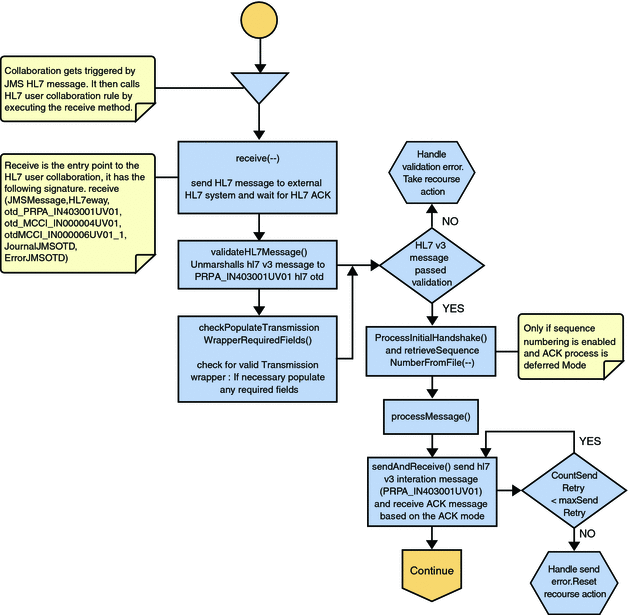HL7 V3 Standard Outbound Message Mode Data Flow (For Immediate and Deferred Mode of ACK Process) — Part 1
The Collaboration is triggered by a JMS HL7 V3 message. The Collaboration then calls the HL7 V3 User Collaboration Rule by executing the receive method. Receive is the entry point to the HL7 V3 User Collaboration, with the following signature:
receive (input, otdHL7eWay_1, otdJMS_JOURNAL, otdJMS_ERROR, otd_MCCI_IN000004UV01_1, otd_MCCI_IN000006UV01_1, otd_PRPA_IN403001UV01_1) |
The incoming HL7 V3 message is then validated, making sure that the message structure is correct. Various fields in the Transmission Wrapper of the message are also validated, such as Version Code, Processing Code, Processing Mode Code, and Interaction ID.
If the message does not pass validation, an error occurs and the associated recourse action is applied. If the HL7 V3 message passes validation, the message moves on to processInitialHandshake() to receive a sequence number (if sequences numbering is enabled only for Deferred Mode). The Collaboration takes the sequence number from the sequencing numbering file and determines the next number to use. This number is then inserted into the HL7 V3 message.
Next, the message moves on to processMessage(), which calls the helper method, sendAndReceive(). The sendAndReceive method sends the HL7 V3 message, waits for an HL7 V3 ACK message, and processes the ACK or NAK. The validation also checks the message structure to see if the message is unmarshaled. If a valid ACK is not received, it continues to send the HL7 V3 message up to the configured number of retries, at which time an error occurs and the associated recourse action is taken.
Figure 20 Immediate and Deferred Mode of ACK Process — Part 1

- © 2010, Oracle Corporation and/or its affiliates
